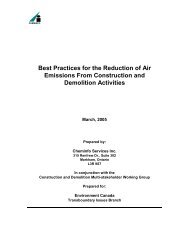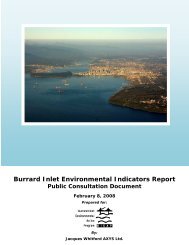Biodiversity Conservation - the BIEAP and FREMP Website
Biodiversity Conservation - the BIEAP and FREMP Website
Biodiversity Conservation - the BIEAP and FREMP Website
You also want an ePaper? Increase the reach of your titles
YUMPU automatically turns print PDFs into web optimized ePapers that Google loves.
Breakout Sessions Concerning <strong>the</strong> Ten Strategic Directions | Key Points<br />
6<br />
Silhouette of migrating s<strong>and</strong>hill cranes. Loss <strong>and</strong><br />
degradation of riverine <strong>and</strong> wetl<strong>and</strong> ecosystems is likely<br />
<strong>the</strong> greatest threat to <strong>the</strong>se birds in British Columbia.<br />
Burns Bog <strong>and</strong> Pitt Meadows provide important breeding<br />
<strong>and</strong> staging habitat for <strong>the</strong> greater s<strong>and</strong>hill crane,<br />
Grus canadensis tabida, one of <strong>the</strong> three North America<br />
migratory subspecies of s<strong>and</strong>hill crane.<br />
Protected Areas Management continued<br />
Participant Comments about Tactics continued<br />
Lots of dike lots were privately-owned <strong>and</strong> are being<br />
dissolved for municipalities to take over. There is big<br />
pressure to make every dike a trail.<br />
We need adequate buffers. We also need to have a<br />
discussion with ALC regarding having buffers between<br />
dike trail <strong>and</strong> agricultural l<strong>and</strong>. This will be difficult<br />
because it means loss of some agricultural l<strong>and</strong>.<br />
There is a need to consider invasive species.<br />
In <strong>the</strong> removal of invasive species we need a plan<br />
for what will be done after <strong>the</strong> species are removed<br />
o<strong>the</strong>rwise it’s not really worth doing. We should form<br />
best practices in Metro Vancouver <strong>and</strong> have <strong>the</strong>m in<br />
place so everyone can benefit.<br />
There are a lot of initiatives in place doing good work<br />
but not enough staff to coordinate efforts or get things<br />
rolling in a coordinated way.<br />
Enforcement of protected areas is key. In <strong>the</strong> Metro<br />
Vancouver area <strong>the</strong>re are closures of protected areas<br />
because of species at risk, but are those rules enforced?<br />
With corridors, if you’re missing one segment it is<br />
rendered far less valuable. We need to focus on key<br />
missing segments; also need to protect/secure linking<br />
pieces that are at risk of being lost.<br />
Regarding <strong>the</strong> riparian areas regulation, no one is<br />
supposed to use this area but of course people will/do.<br />
Is it acceptable to keep people out?<br />
Strategic Directions for <strong>Biodiversity</strong> <strong>Conservation</strong> in <strong>the</strong> Metro Vancouver Region | Forum Proceedings: Key Points <strong>and</strong> Potential Action Steps<br />
There are ways of protecting l<strong>and</strong> that is not owned<br />
by <strong>the</strong> public. It should be secured as heritage buildings<br />
are, that is, whoever owns it knows what <strong>the</strong>y have<br />
to protect.<br />
There are all <strong>the</strong>se tools that have been used for<br />
various types of control over l<strong>and</strong>. We need a list with<br />
strengths <strong>and</strong> weaknesses for how various tools have<br />
been used <strong>and</strong> what for, e.g. for buffer zones. We’ve got<br />
a number of useful tools where it has not been widely<br />
communicated how <strong>the</strong>y can be used.<br />
The Green Bylaws Toolkit is very useful for<br />
developing areas.<br />
Managing l<strong>and</strong>s adjacent to protected areas is also an<br />
issue. In protected areas, you can at least zone <strong>the</strong>m to<br />
exclude a set of activities, etc.<br />
The Pacific sea nettle, Chrysaora<br />
fuscescens, is a jellyfish commonly<br />
found on <strong>the</strong> west coast of<br />
North America. Jellyfish play<br />
an important role in marine<br />
food webs. They feed mostly on<br />
zooplankton, comb jellies <strong>and</strong><br />
o<strong>the</strong>r jellyfish <strong>and</strong> are preyed<br />
upon by sea turtles, sunfish,<br />
spadefish, crab <strong>and</strong> o<strong>the</strong>r large<br />
crustaceans. Degradation of <strong>the</strong><br />
world’s oceans however, due to<br />
pollution, overfishing, <strong>and</strong> global<br />
warming, favour jellyfish blooms,<br />
causing fish reduction <strong>and</strong> a chain<br />
of associated problems.<br />
17
















